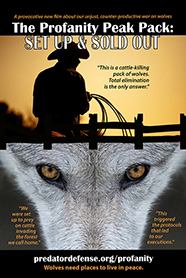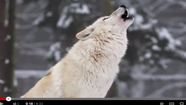Wolf Myths & Facts
Information the wolf hunters and trappers don’t want to believe and don’t want you to know
MYTH: There are plenty of gray wolves in America...over 100,000.
FACT: There are likely fewer than 7,000 gray wolves left in the entire lower 48 states. The gray wolf's long-term survival is at stake. It has barely begun to recover from being endangered, and is still absent from significant portions of its former range, where substantial suitable habitat remains. A growing body of scientific literature shows that top predators, like the wolf, play critical roles in maintaining a diversity of other wildlife species.
Read more below, and in letter from 16 of the nation's top scientists, sent May 21, 2013 to Sally Jewell, Secretary, Department of the Interior.
Source: Population estimates from state wildlife agencies
* * * * * * *
MYTH: Wolves kill lots of cattle, lead to lower birth rates, and are causing cattle ranchers to go out of business.
FACT: Wolves are responsible for less than two tenths of a percent (.2%) of cattle depredations. 94% of losses are due to non-predator related causes, such as respiratory disease, digestive problems, weather, calving problems, etc.
For example, according to the USDA there were 3,992,900 cattle deaths reported in 2010. A whopping 3,773,000 were not due to predators at all. In fact, only 219,900 were due to predators. Of those losses attributed to predators, wolves came in at second to last at 8,100. Furthermore, these losses are "self-reported" by ranchers, and most studies show that ranchers typically attribute any unknown causes to "predators," which increases the number of "losses."
Of special note, even dogs, which are listed as cattle predators, killed almost three times as many cows as wolves did, at 21,800.
Source: “Cattle Death Loss,” a report by the USDA National Agricultural Statistics Service (see chart on pg. 5)
* * * * * * *
MYTH: The elk population has been declining, due to wolf depredation.
FACT: The numbers show the OPPOSITE is happening. In Wyoming and Montana there are more elk now than before reintroduction.
In Wyoming, elk are 29 percent above management objectives and Wyoming Fish and Game says they are actually “managing elk to reduce their numbers”! In Montana, elk populations have increased by approximately 60 percent since wolf reintroduction. Idaho elk are at or above management objectives in 80 percent of the state elk hunting units.
Source: “The Perverse Logic of Wolf Hunts”
* * * * * * *
MYTH: Gray wolves in the Yellowstone region are "non-native imports" dumped into the area.
FACT: Northern Rocky Mountain wolves, a subspecies of the gray wolf (Canis lupus), were native to Yellowstone when the park was established in 1872.
The Park Service recorded killing 136 gray wolves in Yellowstone between 1914-1926. There were most certainly many more killed prior to that; they just weren't keeping records. By the 1940s, wolf packs were rarely reported, and by the 1970s scientists found no evidence of a wolf population. The species of gray wolf imported from Canada and reintroduced into Yellowstone in 1995 is the same wolf species that originally inhabited the Park.
Source: The National Park Service
* * * * * * *
MYTH: Wolves are not endangered and should not receive endangered species protection.
FACT: Wolf management in America has swung full circle in 50 years from extermination to recovery, and now back again towards extinction. Never in the history of the Endangered Species Act has a species been delisted because of politics, but that is what happened when wolves were delisted on the federal level in April 2011, and management was left to the states.
This established a dangerous precedent. State managers opened hunting seasons on wolves who had just managed to gain a toe-hold and reoccupy territory from which they were extirpated by ranching and agricultural interests just a few decades ago. Ranching and hunting interests historically dominate state commissions and legislatures, so the playing field is not level. It is therefore no surprise that state wildlife management decisions are based on political special interests, as opposed to science.
Wolves are highly social animals and their health, as well as the balance of the ecosystem, depends on their pack structure. As a result of their delisting, free roaming packs of wolves in America will be lucky to survive, much less thrive, anywhere outside of the national parks, where they are protected. Hunters and trappers are gaining access to those wolves as well, by lying in wait for them when they cross the park boundaries, as has happened in Montana, Wyoming and Idaho.
Read more about wolves' endangered status in letter from 16 of the nation's top scientists, sent May 21, 2013 to Sally Jewell, Secretary, Department of the Interior.
Learn more in our film, “The Imperiled American Wolf”
* * * * * * *
MYTH: Wolves should just live in parks like Yellowstone (or in Canada).
FACT: Not only is this unhealthy for the predator/prey balance in the states which have wolf populations, but wolves have never recognized the boundary line between Canada and the U.S. Nor, of course, do they recognize the boundary line between Yellowstone National Park and the surrounding states. Wolves that leave Yellowstone have been shot by hunters as soon as they step across the border. See New York Times article.
Learn more about predator/prey balance in The Importance of Predators.
* * * * * * *
MYTH: There are plenty of wolves in Canada and Alaska. If we have problems here, we can just import some from there.
FACT: That is not in the least bit desirable. Wolves are highly social animals. Family structure is vital to their health and well-being. It would be ill-advised to disrupt the social structure of wolves in those locations.
Learn more in our film. “The Imperiled American Wolf”
* * * * * * *
MYTH: Wolves kill for sport and for thrills.
FACT: Wolves kill for survival; they kill for food. And when they kill they are often engaging in a very dangerous activity, taking down animals that weigh many times more than them. If they leave part of a kill behind, they are planning to come back for future feedings. Just as beneficially, what wolves kill feeds other animals.
Read more in The Truth about Wolf Surplus Killing: Survival, Not Sport - Outside Magazine, April 5, 2016.
* * * * * * *
MYTH: Wolves are simply a problem. They need to be removed from the ecosystem.
FACT: Our ecosystems are out of balance when it comes to predator and prey. Predators are essential to restoring balance and ensure proper ecosystem processes and function. As a major predator, wolves have shaped prey populations for thousands of years.
Wolf predation is strategic; it differs from how humans hunt. Wolves primarily take the young and old, rather than the largest and healthiest animals. Wolf predation also helps to balance prey numbers with available habitat, ensuring that plant communities get periodic rest from heavy browsing or grazing influences of herbivores. Wolves can also affect habitat use—for instance, in Yellowstone there is evidence that wolf presence has shifted elk use from valley bottom streamside areas to uplands, which has benefited vegetation important to many wildlife species.
Finally, the presence of wolves can also affect the population and distribution of other smaller predators like coyotes, foxes and skunks. Changes in the population and distribution of these species can have cascading effects on other species from ground-nesting birds to small mammals.
Read more about The Importance of Predators and watch our film, “The Imperiled American Wolf”
* * * * * * *
MYTH: Wolves are a deadly menace to humans.
FACT: There have been only two incidents where wolves have killed humans in North America in the past 100 years, once in 2005 and once in 2010. This is an extremely rare rate of occurrence.
Wolves have a natural fear of people that is only eroded when they learn to associate humans and human settlement with opportunities to find food. Importantly, both of these fatalities took place near illegal garbage dumps that attract a host of scavenging carnivores other than wolves, including bears and coyotes. Also, in both cases, there is controversy as to whether or not wolves were the perpetrators.
To put these two wolf killings in 100 years in context, consider that domestic dogs kill 20 to 30 people in the U.S. every year. And an average of two hunting fatalities occur each year in the state of Oregon alone (see ODFW fatalities report). And every year hunters in the U.S. and Canada kill nearly 100 people and injure around 1,000 (more).
Source: Living with Wolves, Oregon Dept. of Fish and Wildlife Hunting Incidents, and International Hunter Education Association reports


